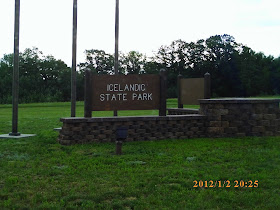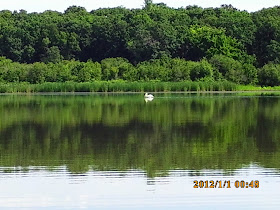Patricia, a reader of this blog from Omaha who also paddles lakes and streams in South Dakota, has sent me a new guest narrative describing her recent cruise on Renwick Lake, located in Icelandic State Park, North Dakota. This is Patricia’s third guest narrative this season; her observations and experiences closely reflect my own solitary cruises.
Icelandic
State Park, containing Renwick Lake, is located a few miles east of Cavalier,
ND, near the Canadian border.
There is a dam at the east end, which is causing detours during work,
and the Tongue River is somewhere at the other end.
I was in
search of the river and started out about 10:45 from the boat ramp.
It was a
clear and windless day, so paddling was easy. I started to the left along the dam, and then came across a
steep bluff filled with cliff swallow nests. The bank was teeming with swallows darting in every
direction and landing in the holes.
I paused to watch them speeding around.
In the
reeds that fringed most of the lake shoreline, I discovered these two fugitives
from the park beach over on the north shore. This being a Tuesday, there was no one else on the water,
and only one family on the beach when I finally pulled out. Their mom told me the park was often
deserted on weekdays, but very busy on the weekends.
Further
along the south shore I came to the golf course. It looked like a Grecian sylvan scene – with golf
carts. I stopped hugging the shore
and paddled out to get a closer look at what appeared to be a large rock but
turned out to be an equally large tree trunk.
I was
enjoying this paddle with the cool temperatures, calm water, and solitude. The only human activity I saw was an
occasional crop duster overhead, including one biplane. I continued toward the west end of the
lake, keeping an eye out for the Tongue River. There were several areas of dense vegetation in the water
along the shores that hampered my exploration. I picked my way very carefully through these and found a den
of some sort on the shore, but no river yet.
There was
lots of bird noise and activity around the lake. I spied this pelican at the far north end and paddled toward
him, hoping he might lead me to the river’s mouth, but found only more reeds
and trees. I was having a great
day anyway.
As I turned
back, the placid water made for some impressive reflections of the great clouds
overhead, adding to the splendor of the lake’s solitude and peace (But still, no river.)
I was
beginning to feel like I would never find the river. I paddled back along the west shore, getting stuck and
freeing myself from the matted vegetation, when I caught a glimpse of the
smallest break in the trees.
It was
barely discernable, but there was the river, finally. It was very narrow where it flowed into the lake, but as I
entered it became a decent-sized stream.
The banks were mostly reeds with groups of trees.
I paddled
up the twisting river about half an hour until I approached what appeared to be
the beginnings of a beaver dam. I
didn’t want to disturb it, so I turned and headed back to the boat ramp.
There were
several spots in the banks that appeared to be where animals would come down to
the water, but I never saw any.
I pulled
out of the water about 1:00 p.m.
Renwick Lake was a great kayak trip for me, with beautiful scenery and
the potential for birds and wildlife sightings. It didn’t hurt that the weather was so cooperative. But brother, it’s a long drive north!
My
apologies fore the date stamp on the pictures; I changed batteries and forget
to reset the camera. Argh!



















































